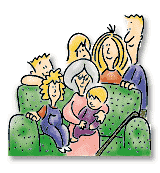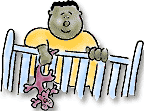Learn more about the proper car seat for your child.
UPMC Children’s Hospital of Pittsburgh and the National Highway Traffic Safety Administration (NHTSA) recommend car seats or booster seats for children who are 8 years old or younger and for children over the age of 8 who weigh 80 pounds or less. The best time to purchase a car seat is before your baby is born so you can learn how to install and use it properly. Car seats, when properly used, can reduce the chance of death by 90 percent and injury by 70 percent.
There are many different types of car seats on the market for children of different ages. For example, infant car seats (for babies weighing up to 20 pounds) are designed so that newborns face the back of the car.
The law requires the following:
- The Law requires children to be rear facing until at least age two. Best Practice is to stay rear facing for as long as the height and weight allows on the car seat. Rear facing is the safest position in a car.
- The Law requires children to stay in a five point harness until at least age four. Children age 4-8 must be in an appropriate fitting child booster seat.
- Children who weigh less than 40 pounds: May remain securely fastened in a child restraint system with a full harness appropriate for their age and weight.
- Children who weigh more than 80 pounds or are 4 feet, 9 inches or taller: May be fastened in the safety belt system without using a child booster seat.
- Children under the age of 13 should always sit in the back seat.
Since a car seat can protect your child only if it’s used properly, be sure to follow the manufacturer’s instructions carefully. Also, remember these suggestions:
- If your car seat is used, be sure it meets current safety requirements outlined by NHTSA. To obtain a copy of these requirements, visit the NHTSA website or call 1-888-327-4236.
- Make sure the car seat is secure. It should not move more than 1 inch in any direction. To secure the seat, kneel inside it while you strap it into the car and use a tether strap to secure the child’s car seat to the vehicle seat.
- Make sure harness straps are in the correct slots. They should be tight enough that an adult can fit only one finger under the strap by your baby’s collarbone.
- Use the harness clip and use it correctly. The top of the clip should be level with the child’s armpits.
- Don’t use a car seat after it’s been in an accident. Buy or borrow a new one.
- Never hold your baby in your arms as a substitute for a car seat.
- Never use a lightweight plastic baby lounger or baby carrier as a substitute for a car seat.
If you’re unsure about the safety of your car seat, have it inspected by a trained professional.









 The best time to begin preventing childhood injuries is before you bring your baby home from the hospital. As you prepare for the arrival of your newborn, follow the tips in this section to make your home as safe as possible.
The best time to begin preventing childhood injuries is before you bring your baby home from the hospital. As you prepare for the arrival of your newborn, follow the tips in this section to make your home as safe as possible. Selecting your baby’s crib is one of the most important decisions you’ll make as a new parent. Since your child will spend a great deal of time in their crib, you’ll want to be sure it’s safe.
Selecting your baby’s crib is one of the most important decisions you’ll make as a new parent. Since your child will spend a great deal of time in their crib, you’ll want to be sure it’s safe.